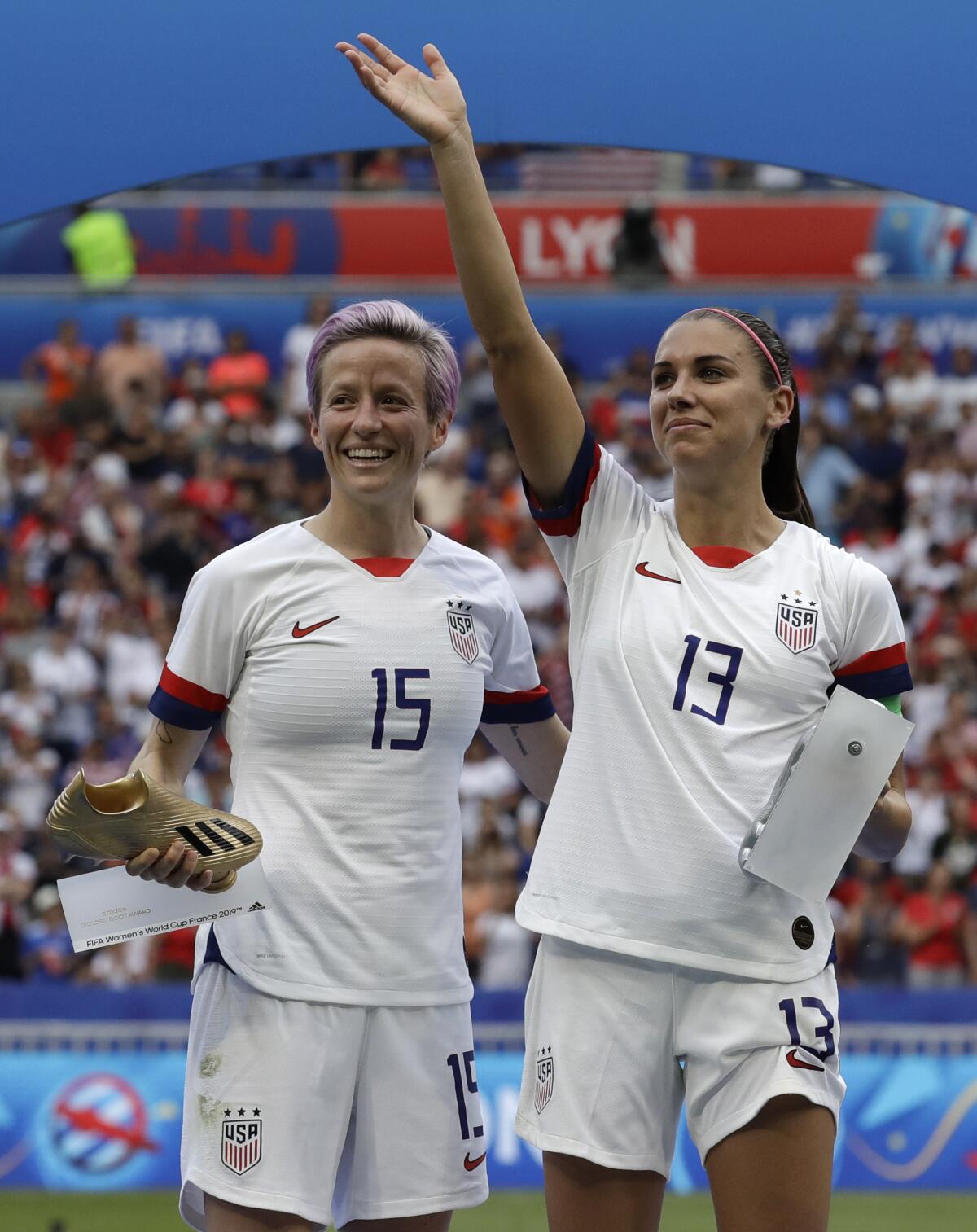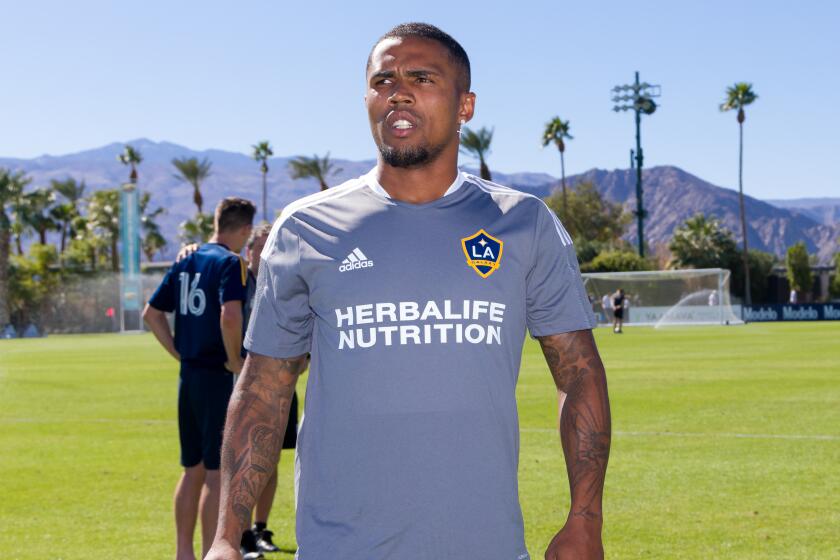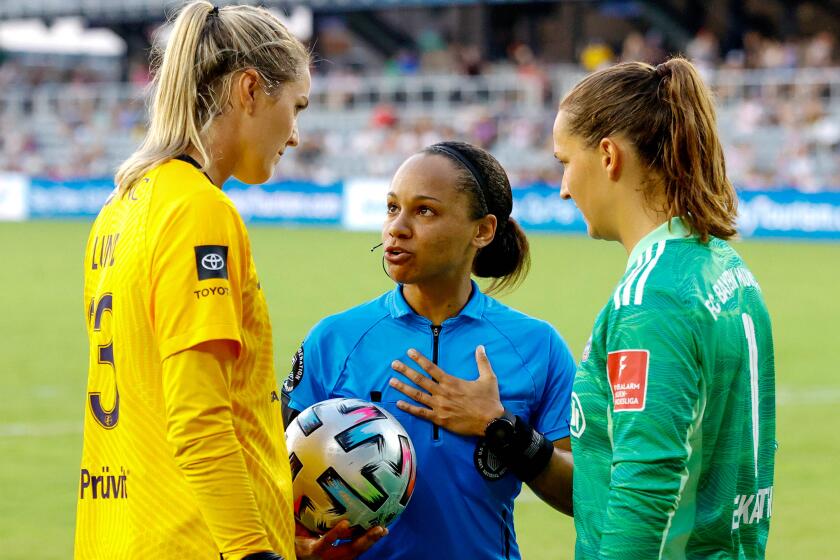Here are the real winners of the USWNT players vs. U.S. Soccer Federation lawsuit

- Share via
Now that women’s national team has settled its long-running legal battle over equal pay with the U.S. Soccer Federation, it’s as good a time as any to wonder about what comes next.
Is this peace in our time or a just temporary pause in hostilities? Is this the thing that will mark this generation of players or will they be remembered more for an unprecedented eight-year run in which they won back-to-back World Cups while losing just eight of 126 games?
It doesn’t really matter. Because when the settlement was announced Tuesday, there were no losers.
“We are pleased to announce that, contingent on the negotiation of a new collective bargaining agreement, we have resolved our longstanding dispute over equal pay and proudly stand together in a share commitment to advancing equality in soccer,” the two sides said in a joint statement.
The civility is a far cry from the sophomoric taunts they had exchanged throughout much of the often-bitter six-year legal fight. That’s probably because neither side can claim outright victory or lament total defeat.
The players, whose class-action lawsuit argued they were not paid the same as members of the men’s national team, agreed to accept $22 million in back pay and the creation of a $2-million fund that can be drawn on for post-career goals and charitable causes aimed at growing the sport for women.
That’s far short of the $66 million the players had sought. But given recent setbacks in court, it’s probably more than they had reason to hope for.
Galaxy acquisition Douglas Costa became a star with Shakhtar Donetsk in Ukraine. Now he watches developments in his former home from afar with fear.
The federation also agreed to pay men’s and women’s senior national team players equally for all friendlies and tournaments. How — or whether — the two national teams will get an equal rate of pay from major tournaments such as the World Cup, where men’s teams are paid considerably more, won’t be determined until negotiations for a new men’s collective bargaining agreement conclude. The men have been without a labor contract since December 2018.
For U.S. Soccer, meanwhile, the settlement ends a costly, embarrassing and ultimately distracting fight it had no chance of winning in the court that mattered most — the court of public opinion.
The federation said the women had rejected a labor agreement virtually identical to the one it offered the men’s team and produced reams of evidence that showed the women were actually paid more.
Didn’t matter. The public didn’t see the two teams as equals.
The women have won four World Cups and four Olympic titles since 1991 while the men have made it as far as the World Cup quarterfinals just once in the modern era and have won just four games in the Olympics since 1991.
Forget equal pay; give the women more than the men.
But rousing equal-pay chants during World Cup victory parades don’t change contracts. The process that moved the federation toward a settlement started in 2016.
Five star players, led by Alex Morgan and Megan Rapinoe, filed a gender-discrimination complaint with the Equal Employment Opportunity Commission, claiming they were treated and compensated differently from members of the men’s national team. Shortly before the last World Cup in 2019, the players withdrew the EEOC complaint and fomally sued U.S. Soccer for gender discrimination.

The two sides reached a settlement in December 2020 over issues including charter flights, hotel accommodations and playing surfaces. But eight months earlier, a California judge had handed the federation a major victory, ruling that it was factually incorrect when it said the women were paid less than the men and granting a motion for summary judgment.
(Last week, when U.S. Soccer released its tax filing for the year that ended March 31, 2021,the five top-paid players listed were all members of the women’s national team. All five received more than $253,000.)
The players were scheduled to challenge that ruling March 7 before the Ninth Circuit Court of Appeals. Tuesday’s announcement means that appeal won’t go forward, but the federation and the players must still hammer out a new collective bargaining agreement for the terms of the settlement to take effect.
Once that happens it could have immediate an impact, both in the short term and long term.
In the short term, it represents a huge win for federation President Cindy Parlow Cone, a former World Cup standout who once boycotted a national team tournament over pay issues. The settlement, which Cone played a huge part in negotiating, ends a long, expensive and damaging chapter for the federation while almost certainly derailing Carlos Cordeiro’s bid for re-election as U.S. Soccer president.
Cordeiro, who was instrumental in convincing FIFA to bring the World Cup back to North America in 2026, resigned as president two years ago, halfway through his four-year term, after lawyers representing U.S. Soccer in the gender-discrimination suit claimed “indisputable science” showed the women players were inferior to their male counterparts.
Cordeiro and Cone are the only candidates on the ballot for next month’s election.
In the long term, the settlement means much more than what either side can claim to have won, although both sides will share in the larger impact. While the players received just a fraction of what they sought, they can argue their claim of gender discrimination has been validated.
Soccer referee Natalie Simon is accustomed to being different and carrying a heavy burden as the highest-ranked Black American woman in her field.
The federation can claim victory, too, since the courts ultimately agreed with it.
And the fact that one of international soccer’s largest and most influential federations has publicly — and legally — committed to treat its men’s and women’s teams equally will increase the pressure on others to do the same.
Norway and Australia already do so, at least on a percentage basis, while women players in several other countries, inspired by the activism of the U.S. team, have recently won concessions over pay and other working conditions. That, ultimately, will leave a bigger legacy than any of the remarkable things this generation of women’s national team players accomplished on the field.
Morgan seemed to grasp that Tuesday.
“This was years and years of fighting and I might benefit from it for a few years,” she said. “But this was really set up for the next generation to be able to really focus on playing soccer and not have to worry about proving their value or demanding the respect they deserve because we were here fighting for that.”
More to Read
Go beyond the scoreboard
Get the latest on L.A.'s teams in the daily Sports Report newsletter.
You may occasionally receive promotional content from the Los Angeles Times.









